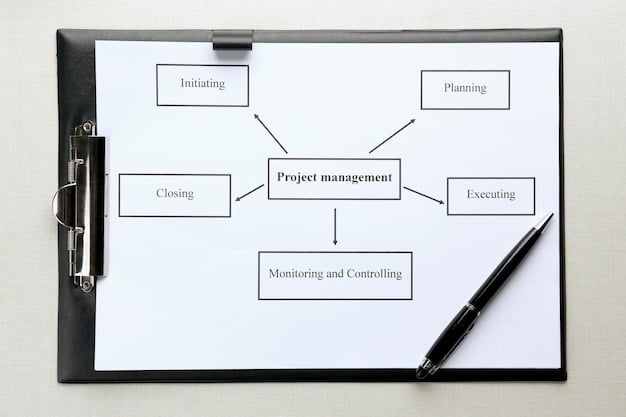Crisis Management: Preparing Your Business for Unexpected Disruptions

Crisis management involves strategies and actions taken by a business to deal with sudden and significant negative events, aiming to minimize damage, restore operations, and protect the organization’s reputation and stakeholders.
Facing the unpredictable nature of the business world, preparing for potential crises is no longer optional but a necessity. Crisis management: preparing your business for unexpected disruptions involves developing strategies and plans to navigate unforeseen challenges, ensuring business continuity, and safeguarding your company’s reputation.
Understanding Crisis Management
Crisis management is not merely about reacting to a disaster; it’s a proactive approach that encompasses risk assessment, planning, and training. It equips businesses with the tools and strategies to effectively respond to and recover from disruptive events.
The goal is to minimize negative impacts, protect stakeholders, and maintain operational stability during turbulent times. It’s about turning potential chaos into a controlled and managed situation.

Key Components of Crisis Management
Effective crisis management relies on several key components that work together to ensure a coordinated and efficient response.
- Risk Assessment: Identifying potential threats and vulnerabilities.
- Planning: Developing a crisis management plan that outlines roles, responsibilities, and procedures.
- Communication: Establishing clear communication channels for internal and external stakeholders.
- Training: Conducting regular training exercises to prepare employees for crisis situations.
Addressing these key components thoroughly can significantly bolster a company’s response capabilities.
In summary, understanding crisis management involves grasping its proactive nature and realizing how its key components work together to protect a business from potential harm.
Assessing Potential Risks
Before formulating a crisis management plan, it’s paramount to identify the risks your business might face. This involves conducting a thorough assessment of internal and external vulnerabilities.
This assessment helps in prioritizing threats and allocating resources effectively to mitigate potential damage.
Identifying Internal Vulnerabilities
Internal vulnerabilities can range from operational inefficiencies to employee-related issues. Recognizing and addressing these weaknesses proactively is crucial for preventing crises before they occur.
- Operational Failures: System breakdowns or production errors.
- Financial Instability: Cash flow problems or debt issues.
- Employee Misconduct: Unethical behavior or legal violations.
Careful evaluation of internal processes can help pinpoint potential areas of concern.
Identifying External Threats
External threats are often beyond a company’s direct control but need to be considered in crisis planning. These include economic downturns, natural disasters, and cyberattacks.
Being aware of potential external factors allows businesses to anticipate and prepare for various scenarios.
Ultimately, assessing potential risks provides the foundation for a robust crisis management plan, enabling businesses to navigate unforeseen challenges effectively.
Creating a Crisis Management Plan
A well-crafted crisis management plan serves as a roadmap for navigating emergencies. It provides a structured approach to decision-making, communication, and action during times of uncertainty.
This plan should be comprehensive, regularly updated, and easily accessible to all relevant personnel.

Essential Elements of a Crisis Management Plan
Several essential elements must be included in a crisis management plan to ensure its effectiveness. These elements cover various aspects, from defining roles to establishing communication protocols.
- Designated Crisis Team: A team of individuals responsible for managing the crisis.
- Communication Protocols: Guidelines for internal and external communication.
- Action Plans: Step-by-step procedures for addressing specific crisis scenarios.
- Resource Allocation: Identifying and securing necessary resources for crisis response.
Adhering to these essential elements can streamline the response process.
Regularly Updating the Plan
A crisis management plan is not a static document; it should be regularly updated to reflect changes in the business environment, new risks, and lessons learned from past incidents.
This ensures that the plan remains relevant and effective in addressing current and future challenges.
To conclude, creating a crisis management plan is an essential step in preparing for disruptions, providing a framework for coordinated and effective response.
Establishing Communication Strategies
Clear and timely communication is critical during a crisis. Establishing effective communication strategies ensures that stakeholders receive accurate information, fostering trust and minimizing panic.
These strategies should address both internal and external communication needs.
Internal Communication Protocols
Internal communication protocols ensure that employees are informed, and that the information flow is consistent and accurate. This helps maintain morale and productivity during a crisis.
Keeping employees in the loop reduces uncertainty and speculation.
External Communication Strategies
External communication strategies focus on managing the company’s reputation and maintaining relationships with customers, investors, and the media. Transparency and honesty are paramount.
Addressing concerns and providing regular updates can help mitigate negative publicity.
- Media Relations: Develop relationships with key media contacts.
- Social Media Management: Monitor and respond to social media activity.
- Customer Communication: Keep customers informed about the situation and any impact on services.
Managing external communications effectively protects the brand and stakeholder confidence.
In summary, establishing communication strategies is vital for managing perceptions and maintaining trust during a crisis, both inside and outside the organization.
Training and Simulations
Preparing employees for crisis situations through training and simulations is crucial for ensuring a coordinated and effective response. These activities help familiarize personnel with the crisis management plan and their roles within it.
This hands-on approach enhances readiness and decision-making abilities under pressure.
Conducting Training Exercises
Training exercises should cover a range of potential crisis scenarios, providing employees with practical experience in applying the crisis management plan. This includes tabletop exercises, simulations, and drills.
Regular training builds confidence and competence.
Benefits of Crisis Simulations
Crisis simulations offer a realistic environment for testing the crisis management plan and identifying areas for improvement. They also help in building teamwork and enhancing communication skills.
Simulations uncover weaknesses that may not be apparent in theoretical planning.
Ultimately, training and simulations are essential for transforming a well-written plan into a well-executed response, ensuring that the organization is prepared to face real-world crises.
Post-Crisis Evaluation and Recovery
The crisis doesn’t end when the immediate danger has passed; a thorough post-crisis evaluation and recovery phase is critical for learning from the experience and restoring operations. This involves assessing the effectiveness of the crisis management plan and implementing necessary improvements.
It’s about turning a crisis into an opportunity for growth and resilience.
- Assessing the Response: Evaluate the effectiveness of the crisis management plan and identify areas for improvement.
- Restoring Operations: Develop a plan for restoring normal business operations.
- Employee Support: Provide support and counseling to employees affected by the crisis.
- Updating the Plan: Incorporate lessons learned into the crisis management plan.
Long-Term Recovery Strategies
Long-term recovery strategies focus on rebuilding trust with stakeholders and implementing measures to prevent future crises. This includes reassessing risk factors, updating policies, and enhancing training programs.
A proactive approach to prevention is the best way to minimize future disruptions.
In essence, post-crisis evaluation and recovery are integral parts of the crisis management process, ensuring that the organization learns from the experience and emerges stronger and more resilient.
| Key Point | Brief Description |
|---|---|
| ⚠️ Risk Assessment | Identify internal and external vulnerabilities to prioritize threats. |
| 📝 Crisis Plan | Create a roadmap for decision-making and action during emergencies. |
| 🗣️ Communication | Establish clear channels for internal and external stakeholders. |
| 👨💼 Training & Simulations | Prepare employees with practical experience in crisis response. |
FAQ
▼
The main goal is to minimize the negative impact of a crisis, protect stakeholders, and restore normal business operations as quickly as possible. Effective strategies and communication are essential.
▼
Risk assessment helps identify potential threats and vulnerabilities, allowing businesses to prioritize risks and allocate resources effectively to mitigate potential damage. Being proactive is key.
▼
Key elements include a designated crisis team, communication protocols, action plans, and resource allocation. These elements provide a structured approach to managing and resolving emergencies effectively.
▼
A crisis management plan should be updated regularly, at least annually, to reflect changes in the business environment, new risks, and lessons learned from any past incidents. Keeping it current is vital.
▼
Communication is critical for informing stakeholders, reducing panic, and managing the company’s reputation. Clear, timely, and accurate communication builds trust and helps mitigate negative impacts.
Conclusion
In conclusion, crisis management is an indispensable aspect of running a successful business, especially in today’s unpredictable environment. By understanding the importance of proactive planning, thorough risk assessment, and effective communication strategies, businesses can significantly enhance their resilience and ability to navigate unexpected disruptions. Investing in comprehensive training, simulations, and regular plan updates ensures that organizations are well-prepared to protect their stakeholders, maintain operational stability, and emerge stronger from any crisis.





